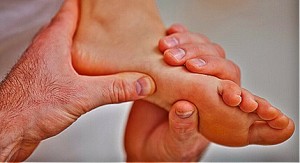Chronic Ankle Instability – ‘my ankle hurts – what helps?’
We’ve all done it. A quick step, a sudden crack in the sidewalk, landing from a basketball rebound, or tripping over a teenagers shirt left on the stairs. The dreaded ankle sprain.
Big census data collections tell us these simple and often innocuous injuries are the most common musculoskeletal injury. A newer concept of of ‘chronic ankle instability’ or CAI for short, is characterized by those unlucky few (actually more like 40% of those experiencing an acute ankle sprain progress to CAI) as recurrent sprains, multiple episodes of the foot/ankle giving way, persistent pain, and diminished self-reported function for at least one-year post ankle sprain. Even more frustrating, studies tell us 70% of people experiencing CAI are unable to maintain prior levels of physical activity – this spans the entire spectrum from daily walking for aerobic exercise to rock climbing Talcott Mountain. This is a massive deal! What can we do? How can Physical Therapy help? What do I need to do at home?
Let’s review:
Pathomechanics (big fancy anatomy words) and CAI
Once a person has experienced multiple ankle sprains, 3 major things occur.
1. Balance: An altered postural control has been noted during both static and dynamic balance activities. This perpetuates the problem, less balance, poor postural control = more ankle sprains.
2. Walking: Muscular activation during walking becomes altered. This is as good as any of a time as any to mention that ‘ankle sprains’ are injuries that affect the ligamentous structures of the lateral or outside ankle. While dynamic or muscular control plays a vital role in the function of the ankle, these injuries creating CAI are specific to the ligaments of the ankle (for those of extreme interest, they are listed below *). So how does an injury to a ligament alter ones’ muscles? As someone walks with CAI, it’s been shown that just prior to the foot striking the ground, it slightly inverts, or tilts inward. This is thought to be due to an increased laxity in the joint itself. Due to the fact that it is inverted, our body weight as we initially contact the ground creates even more ground reaction forces causing an even greater inverted or tilted foot. As a result important muscles, most specifically the peroneus longus activates too early and way to long. The result equals earlier fatigue, onset of pain, and again a loss in postural control. It quickly becomes a cyclical pattern.
3. Jogging/Running: note the above and multiply the forces anywhere from 5 to 25x the stress of walking. Now it makes sense why so many suffering from CAI have an alteration in their functional activities.
So what can we do? What are the effects of properly completed & established therapeutic exercise?
Exercise helps period. Better more patient specific focused exercise helps even quicker. Ross and Guskiewicz (1) utilized single-leg foam balance, wobble board exercises, and resistance band kicks for 10 minutes per day, five days per week; that’s solved by simply exercising during your commercial tv breaks! They found that anterior-posterior and medial-lateral stabilization deficits could be markedly improved with only four-weeks of focused intervention. Changes were dramatic, and allowed individuals back to prior functional activities, in theory breaking the cycle.
Each foot is different, each needs a specific evaluation to determine the anatomy involved and research has shown us specific training helps.
Matt Calendrillo PT, BOCOP
Doctorate of Physical Therapy, Board Certified Orthotist/Prosthetist, founder
LIVE EVERY DAY
A Physical Therapy, Orthotics, Prosthetics Co.
138 Hopmeadow St.
Simsbury, CT 06089
liveeveryday.org
A full complement of private outpatient services with clinical excellence in orthopedics & neuromuscular re-education throughout the entire age spectrum. Our care is uncompromised. Our results surround a patient-first model: always one-to-one treatments with personalized goals, and a full systematic approach.
* Syndesmosis (includes AITFL, PITFL, TTFL, IOL, ITL)
Anterior talofibular ligament (ATFL)
Posterior talofibular ligament (PTFL)
Calcaneal fibular ligament (CFL)
Lateral talocalcaneal ligament (LTCL)
Meta-tags: Rehabilitation, Ankle Sprain, Physical Therapy, Simsbury, CT, Connecticut, Ankle Brace, AFO, Matt Calendrillo, Calendrillo, LIVE EVERY DAY, Orthotics, Prosthetics.


